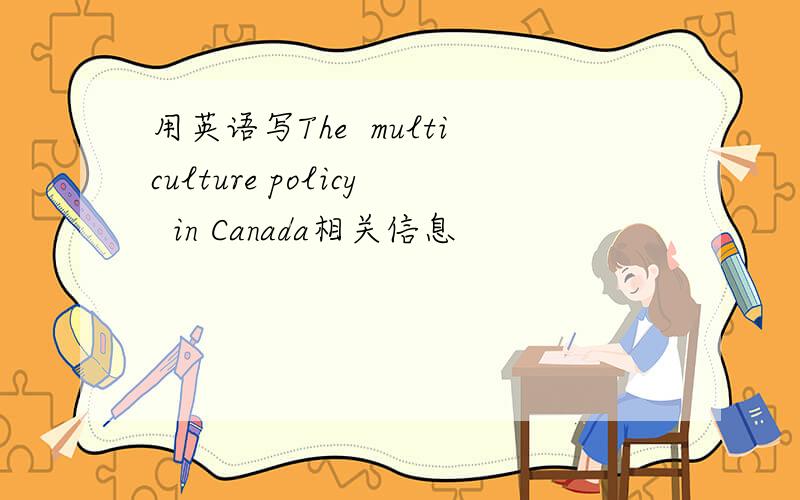用英语写The multiculture policy in Canada相关信息
来源:学生作业帮助网 编辑:作业帮 时间:2024/04/25 20:37:46

用英语写The multiculture policy in Canada相关信息
用英语写The multiculture policy in Canada相关信息
用英语写The multiculture policy in Canada相关信息
The Multicultural Policy in Canada
How should Canadians deal with this pluralism of origin?In 1971,the federal government announced its policy of multiculturalism.The policy not only recognized the reality of pluralism in Canada,but seemed to reverse the earlier attempt to assimilate immigrants.It challenged all Canadians to accept cultural pluralism,while encouraging them to participate fully and equally in Canadian society.
Many factors influenced the introduction of the multiculturalism policy.Most of all,it must be seen as a product of its time.The mid-1960s were marked by increasingly troubled English-French relations in Canada.The government appointed a Royal Commission to study and recommend solutions to outstanding problems.The Royal Commission on Bilingualism and Biculturalism held hearings across Canada.The commissioners heard about more than just English and French relations.Ethnic spokespersons everywhere argued that the old policy of assimilation was both unjust and a failure.They told the commissioners that immigrants and their children had endured the Great Depression side-by-side with other Canadians; they had sacrificed sons and daughters to the national war effort,and they now reaped the benefits of Canada's economic revival and their own hard work.They might not be of English or French heritage,but they declared themselves to be not one bit less Canadian,and they would not be excluded from the public debate.
They urged that a new model of citizen participation in the larger society be adopted--one that addressed the pluralism of ethnic groups that were part of the Canadian family.They offered a blueprint for a Canadian identity based on public acceptance of difference and support of cultural pluralism.Unlike the melting pot model of the United States,they preferred the idea of a cultural mosaic--unique parts fitting together into a unified whole.Ethnicity,they argued,did not undermine Canadian identity.It was Canadian identity.
To the surprise of many,the Commission seemed to agree.In Volume IV of its Report,the Commission presented the government with sweeping recommendations which would both acknowledge the value of cultural pluralism to Canadian identity and encourage Canadian institutions to reflect this pluralism in their policies and programs.When the policy was announced,it was one of multiculturalism within a bilingual framework.Multiculturalism affirmed English and French as the two official languages of Canada.But ethnic pluralism was declared to be a positive feature of Canadian society worthy of preservation and development.Many provinces followed the federal lead by introducing multiculturalism policies in their areas of authority.In l988,Bill C-93 was passed as the Canadian Multiculturalism Act.It became the first formal legislative vehicle for Canada's multicultural policy.
Not all Canadians supported multiculturalism.For example,in English-speaking Canada some worried that multiculturalism would divide Canadians rather than unite them.Others feared that multiculturalism would erode the rich British heritage of English-speaking Canada.Many in Quebec protested that multiculturalism was designed to undermine Quebec nationalism.Ottawa,they charged,would use multiculturalism to thwart Quebec's aspirations by equating it with "other" ethnic groups in Canada.
But many,especially in urban English-speaking Canada,supported the policy.They saw it as a timely recognition of a pluralism that was a fact of Canadian life.When the policy was announced in 1971,the Canadian ethnic mosaic was still very much dominated by those of European heritage and was designed to recognize their contribution to Canada.However,as immigration to Canada from the developing world increased,the multiculturalism policy had to deal with the concerns of visible minorities.These new and emerging communities were less worried about recognition of their heritage in Canada.They looked to the multiculturalism policy,not for support of cultural enrichment but rather for aid in the elimination of racial prejudice and discrimination.They wanted to ensure equal access to jobs,housing and education.
The government responded.While it did not turn its back on the kind of culturally-based programming which dominated the early years of the multiculturalism policy,it did address issues important to the newer groups.In 1981,federal multiculturalism officials established a unit devoted to race relations in Canada.This was later expanded to make race relations a primary focus of the multicultural policy.Most provinces and many larger municipalities have followed suit within their areas of jurisdiction,primarily education,policing,social services and the protection of human rights.In Quebec,which still had difficulty with the term multiculturalism,the provincial government has developed its own programs in response to the new ethnic and racial reality.These programs are similar in many ways to those of the other provinces and the federal government.Today,most federal multicultural programs focus on institutional change,race relations and citizen integration and participation.The federal multiculturalism policy costs Canadians about one dollar each per year.